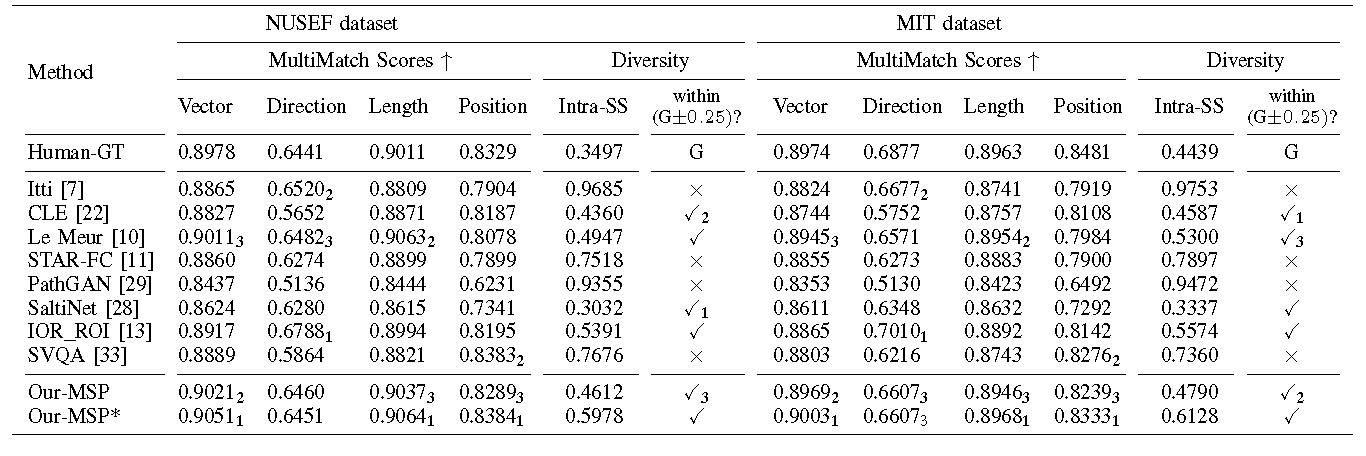Generative Augmentation Driven Prediction of Diverse Visual Scanpaths in Images
Ashish Verma, Debashis Sen
Department of Electronics and Electrical Communication Engineering
Indian Institute of Technology Kharagpur, India
Abstract
Visual scanpaths of multiple humans on an image represent the process by which they capture the information in it. State-of-the-art models to predict visual scanpaths on images learn directly from recorded human visual scanpaths. However, the generation of multiple visual scanpaths on an image having diversity like human visual scanpaths has not been explicitly considered. In this paper, we propose a deep network for predicting multiple diverse visual scanpaths on an image. Image-specific hidden Markov model based generative data augmentation is performed in the beginning to increase the number of image-visual scanpath training pairs. Considering a similarity between our generative data augmentation process and the use of long short-term memory (LSTM) for prediction, we propose an LSTM based visual scanpath predictor. A network to predict a single visual scanpath on an image is designed first. The network is then modified to predict multiple diverse visual scanpaths representing different viewer varieties by using a parameter indicating the uniqueness of a viewer. A random vector is also employed for subtle variations within scanpaths of the same viewer variety. Our models are evaluated on three standard datasets using multiple performance measures, which demonstrate the superiority of the proposed approach over the state-of-the-art. Empirical studies are also given indicating the significance of our generative data augmentation method and our multiple scanpath prediction strategy producing diverse visual scanpaths.
Highlights
- A visual scanpath predictor network for images, which is trained end-to-end, driven by generative data augmentation.
- A HMM-based generative data augmentation procedure to obtain image-specific training pairs of images & visual scanpaths.
- A training strategy based on the uniqueness of a viewer to generate multiple and diverse visual scanpaths of different viewer varieties for an image.
Proposed Architecture

Sample Results (Full results will be released soon)


Visual Comparison

Download
References
- [7] L. Itti, C. Koch, and E. Niebur, “A model of saliency-based visual attention for rapid scene analysis,” IEEE T-PAMI, no. 11, pp. 1254–1259, Nov. 1998.
- [10] O. Le Meur and Z. Liu, “Saccadic model of eye movements for free-viewing condition,” Vis. Res., vol. 116, pp. 152–164, Nov. 2015.
- [11] C. Wloka, I. Kotseruba, and J. K. Tsotsos, “Active fixation control to predict saccade sequences,” in CVPR, Jun. 2018, pp. 3184–3193.
- [13] W. Sun, Z. Chen, and F. Wu, “Visual scanpath prediction using IOR-ROI recurrent mixture density network,” IEEE T-PAMI, vol. 43, no. 6, pp. 2101–2118, Dec. 2019.
- [22] G. Boccignone and M. Ferraro, “Modelling gaze shift as a constrained random walk,” Phys. A, Statist. Mech. Appl., vol. 331, no. 1-2, pp. 207– 218, Jan. 2004.19.
- [28] M. Assens Reina, X. Giro-i Nieto, K. McGuinness, and N. E. O’Connor, “Saltinet: Scan-path prediction on 360 degree images using saliency volumes,” in ICCVW, Oct. 2017, pp. 2331–2338.
- [29] M. Assens, X. Giro-i Nieto, K. McGuinness, and N. E. O’Connor, “Path-GAN: Visual scanpath prediction with generative adversarial networks,” in ECCVW, Sep. 2018.
- [33] X. Chen, M. Jiang, and Q. Zhao, “Predicting human scanpaths in visual question answering,” in CVPR, Jun. 2021, pp. 10 876–10 885.
